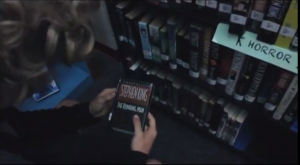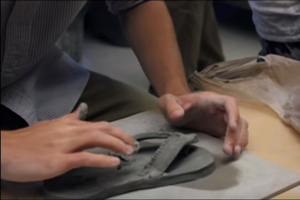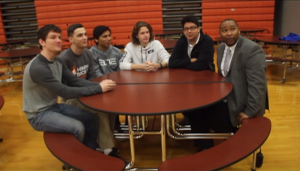As I’ve started thinking about the new school year, I’m focused on developing community in my classroom – in my AP Lit, Humanities English 10 (my PAGES class), and D-Town Video Production. The longer I teach, the more I see the positive effects community building has on my students’ learning as well as their ways of living with each other in the world. One of the more significant successes of community building at the end of this last year involved a group of students in my video production class. They were eagerly gathered around a computer to watch the final version of a video by my student Clay. He wrote, directed, filmed and scored a movie called “The Book Robber”.  This couldn’t have happened a year ago because Clay and three of his classmates from the Transitions classroom wouldn’t have been in my class. Our school’s Transitions students have a variety of developmental disorders, but several are identified as being on the autism spectrum and have characteristics thereof that preclude them from being mainstreamed, but their teachers are always in search of regular ed classes in which they can not only be included, but where they can become a part of the community.
This couldn’t have happened a year ago because Clay and three of his classmates from the Transitions classroom wouldn’t have been in my class. Our school’s Transitions students have a variety of developmental disorders, but several are identified as being on the autism spectrum and have characteristics thereof that preclude them from being mainstreamed, but their teachers are always in search of regular ed classes in which they can not only be included, but where they can become a part of the community.
A year and a half ago, my course had developed a reputation of community building through a small group project-oriented approach to making short films. Early last August, two weeks before school started, Miss Emily, a teaching assistant in our Transitions room, stopped by to let me know that we would be working together this year in D-Town Video Production, as four of her students had been added to my class. This was a joyful surprise to me; the students in the Transitions classroom had previously been successfully mainstreamed into gym class (for both the physical and social benefits). Administration and the Transitions lead teacher had decided that D-Town would be an ideal addition for some of their students. My four new students had varying degrees of autism, and the primary goal for them would be socialization.
Delaware City’s stance on inclusion is in tune with my own – we want our “regular ed” students and our “inclusion” students to have as much interaction as possible for the benefit of both of them. We grow compassionate, patient, thoughtful students who understand that the world is a blend of people of various abilities who all have something to offer.
Twenty years ago, I worked for Goodwill Industries in Columbus by teaching daily living skills to adults and young adults in their homes and in the community, most of that time being spent with a boy named Joey who had moderate autism. When we would be out in the community, I would be saddened by the way Joey was perceived and treated by others – as being so different as to be unaware of how negatively strangers would sometimes treat him. During our two years together, I often thought that my job was only half of what it should have been – I was helping him learn to be in the world, but often it was a world that didn’t know how to be with him. This new opportunity in D-Town would be a realization of what I had always hoped my time with Joey could have been – a chance to develop real community.
Going into last year, the goal I was given for these four young men was to provide them with opportunities to be in community, to build socialization skills. The “regular ed” (I dislike the term, but it is the one my context uses, so I’ll stick with it) students’ video production teams each invited a Transition student (the kids don’t use these words – for them they are just other students) into their groups. The Transition students might hold a reflector to help with lighting, or would even act at times, but I wanted something more for them.
Mid-September, I said to Miss Emily, “What would happen if we put a camera into one of your students’ hands and just let him go with it? What would the world look like to him?” So I asked Austin if we could work together to make a film. He had made attempts at storyboarding when we practiced the skill as a class, but the cognitive process of creating a plot would have required so much prompting from me that I feared the film might take on too much of my own vision. I wanted the film to be his as much as possible, so I asked him if he wanted to film one of the classes at the school, and we talked through which ones would be most interesting to capture on video. He decided to film the ceramics class.
 Before our first visit to the ceramics room, we talked through how he would tell the teacher about his idea for the film and how he would ask the students for their permission to film them. He did both wonderfully, and the students and teacher were enthusiastic about the possibility. Austin and I reviewed how to use the DSLR before class the next morning, then we went to the ceramics room and filmed for the period. I would remind him to watch the camera’s screen to make sure he was keeping the subject in frame, but otherwise he was in control. When we got back to our room the next day, we began editing. I showed him how to use Final Cut Express and guided him through the process, but left him in control. He chose music from a free music website we searched together. He made this film - “Ceramics”. Austin and I had discovered together how rich his and his friends’ experience could be in D-Town, far beyond just socialization.
Before our first visit to the ceramics room, we talked through how he would tell the teacher about his idea for the film and how he would ask the students for their permission to film them. He did both wonderfully, and the students and teacher were enthusiastic about the possibility. Austin and I reviewed how to use the DSLR before class the next morning, then we went to the ceramics room and filmed for the period. I would remind him to watch the camera’s screen to make sure he was keeping the subject in frame, but otherwise he was in control. When we got back to our room the next day, we began editing. I showed him how to use Final Cut Express and guided him through the process, but left him in control. He chose music from a free music website we searched together. He made this film - “Ceramics”. Austin and I had discovered together how rich his and his friends’ experience could be in D-Town, far beyond just socialization.
A month later, I invited Ty’ron, another Transitions student, to make a movie with me. While less verbally communicative than Austin, Ty’ron loved to write on the board and windows of our room. His writing often included drawings, though both still required some interpretation – we were seeing into his way of thinking. So I was excited about the prospects of how he might be able to create more of a narrative than Austin had. Ty’ron showed up the next day with a complete script. The two of us spent the next few weeks working on his film. Again, I showed him how to use the camera and then rehearsed the social interactions with him before he approached the teachers and students he wanted in the film, but otherwise he was in control. He even acted in his film, “New Things! My TKCCSV Things?”: a loosely narrative film in which he polls students and teachers about his favorite things to see which ones they liked best. When we showed his film to the student body in one of our monthly viewings in the auditorium, they cheered with support, both before and after. It was beautiful.
the social interactions with him before he approached the teachers and students he wanted in the film, but otherwise he was in control. He even acted in his film, “New Things! My TKCCSV Things?”: a loosely narrative film in which he polls students and teachers about his favorite things to see which ones they liked best. When we showed his film to the student body in one of our monthly viewings in the auditorium, they cheered with support, both before and after. It was beautiful.
Clay’s project was my last collaboration for the year. He had made a film about lunchtime earlier in the year, but it never really felt like him – it was more of an imitation of the style of film Austin had made. Clay wanted to make a second film and came to me with a multiple scene script about a student stealing a book from the library and then being tracked down by school detectives. Clay was open to discussing and revising the script to make it meet the audience’s needs because he truly cares about movies. In fact, he has an encyclopedic knowledge of film. It is one of his gifts. And his film shows it – you can see gags, plot twists, and exchanges adapted into his film from the many he knows and loves.
We were making this film in the midst of my other students filming their final projects, so time was scarce, but five of the boys in D-Town happily agreed to give up a day and a half of class to act in Clay’s film. Clay described their costume needs and they actually all remembered to bring their materials on the right day (a victory and a rarity – really a sign of their caring for Clay).
I walked with the group to get them into the spaces they would need, but Clay was in control. Occasionally I asked Clay if he wanted to get a second shot of something just in case, but he declined, and he was right to do so. The film turned out wonderfully. For Clay’s film, I was a little more active in the editing process, as he finds the tedium of importing footage difficult, but then he made final edit suggestions and chose the music. He made a film that his new D-Town friends were proud to be in. They had fun making it, and as I watched them I understood it to be an act of caring that I’m not even sure they were aware of. It is just their way of being. Here’s Clay’s film - ”The Book Robber”.
Our D-Town students, through filmmaking, have a chance to grow together in their compassion and understanding of each other. My love of this course has grown exponentially because of this, partially because of the community we have formed, but also because we no longer see boundaries. Everything is possible; anything could lead to an amazing experience. We just need to be open to the moment.
For this next year I am gamifying D-Town so that students work toward badges for the different filmmaking skills (lighting, editing, directing). One of the badges I’m most excited about is the Buddy Badge – I’m going to let go of the control I had this year and invite the regular ed students to partner with the Transition students to mentor them through their own filmmaking process as I have done. The potential for growth for all of them will be wondrous.
We are creating a space together in which we aren’t Transition students and regular ed students. We are filmmaking together, and honoring each other’s unique ways of being through art and community. We are learning to be human together.
Tom Hering, English Teacher